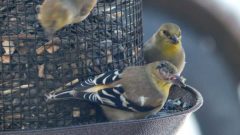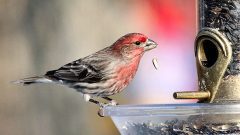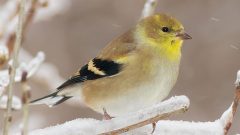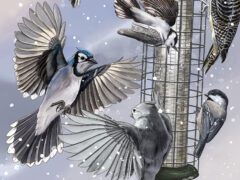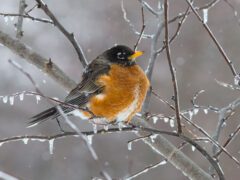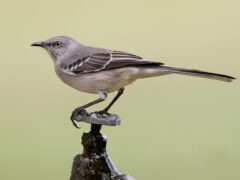American Goldfinch Similar Species Comparison
Main SpeciesAmerican Goldfinch
Breeding male
Small finch with a short, conical bill and a short, notched tail. Breeding males are bright yellow with black forehead, black wings with white markings.
© Darren Clark / Macaulay LibraryIdaho, August 08, 2019Nonbreeding male
Small finch with a conical bill and notched tail. Nonbreeding males are a drab, unstreaked brown, with blackish wings and two pale wingbars.
© Matt Davis / Macaulay LibraryCalifornia, November 08, 2016Breeding male
Often feeds on small-seeded plants such as thistles. Breeding males have black cap, wings, and tail; bright yellow body.
© Jay McGowan / Macaulay LibraryNew York, August 26, 2015Breeding female
Breeding females are duller yellow beneath and more olive above than breeding males.
© Jay McGowan / Macaulay LibraryNew York, April 25, 2016Immature
Immatures are brown above and pale yellow below, shading to buff on the sides. Two buffy wingbars mark their dark wings.
© Jonathan Irons / Macaulay LibraryMaryland, October 25, 2018Breeding male
Song is long and jumbled; may include mimicked elements of other birds' songs. Males sing from high, exposed perches. Note white in tail, which is conspicuous in flight.
© Eric Liner / Macaulay LibraryNew York, May 01, 2006Molting male
Molting male is a patchy mix of breeding and nonbreeding colors.
© Scott Martin / Macaulay LibraryMassachusetts, April 07, 2017Female/immature
Females/immatures are pale yellow below and don't have streaked underparts.
© Tim Lenz / Macaulay LibraryNevada, December 27, 2014Female/immature
These nimble birds feed on small-seeded plants including sycamores. Females are brownish without any streaking and have distinctive, bold black wings with whitish wingbars.
© Jay McGowan / Macaulay LibraryNew York, December 09, 2015Breeding male
Breeding males have a black forehead, a yellow back, and black-and-white wings. Some males have more white-tipped (worn) feathers on their wings than others.
© Ian Routley / Macaulay LibraryBritish Columbia, April 18, 2020In flight
Has a bouncy, undulating flight style. Often calls in flight, with a bird sounding like it is saying "po-ta-to-chip."
© Doug Gochfeld / Macaulay LibraryNew York, November 07, 2020Female/immature
Despite having a fairly small bill for a finch, goldfinches can crack and remove the hard shells of sunflowers, then crush the seed inside before swallowing.
© Timothy Barksdale / Macaulay LibraryMissouri, December 28, 1997Breeding female
Breeding female is yellow below, with black wings, but lacks breeding male's black forehead.
© Don Blecha / Macaulay LibraryIllinois, April 23, 2017Molting male
Molting male has an incomplete black forehead and a patchy mix of bright yellow and brown.
© Tony Dvorak / Macaulay LibraryNew York, April 16, 2020Breeding male
Breeding male is a stunning mix of yellow, black, and white.
© Mason Maron / Macaulay LibraryWashington, May 18, 2020Male and female
Balances on the seedheads of thistles, dandelions, and other plants to pluck seeds.
© Daniel Irons / Macaulay LibraryNew Jersey, September 01, 2019Adult and juvenile
Breeds later than most North American birds, waiting until mid-summer when plants have produced fibrous seeds that adults use to build nests and also feed their young.
© Sunil Thirkannad / Macaulay LibraryKentucky, September 06, 2020Flock
Frequently feeds in flocks at sunflower and nyjer seed feeders.
© Robert Dixon / Macaulay LibraryConnecticut, April 29, 2017Similar SpeciesLesser Goldfinch
Adult male
Adult male Lesser Goldfinches have a complete black crown unlike the partial crown seen on adult male American Goldfinches. They also lack the American Goldfinch's bright yellow back.
© Eric Gofreed / Macaulay LibraryArizona, April 26, 2017Similar SpeciesLesser Goldfinch
Female/immature
Female Lesser Goldfinches have a white rectangle on the wings that female American Goldfinches lack. They also have yellow undertail coverts, whereas the undertail coverts on American Goldfinches are white.
© Arlene Ripley / Macaulay LibraryArizona, June 25, 2017Similar SpeciesLawrence's Goldfinch
Male
Male Lawrence's Goldfinches are grayer overall than American Goldfinches with a black face not seen on either female or male American Goldfinches.
© Terence Brashear / Macaulay LibraryCalifornia, February 21, 2016Similar SpeciesLawrence's Goldfinch
Female
Female Lawrence's Goldfinches have a gray head and back, whereas female American Goldfinches have a yellow head and olive back.
© Brian Sullivan / Macaulay LibraryCalifornia, April 16, 2007Similar SpeciesPine Siskin
Adult (Northern)
Pine Siskins have coarse brown streaks on the breast and back unlike the unstreaked American Goldfinch.
© Douglas Faulder / Macaulay LibraryAlberta, July 30, 2017Similar SpeciesEvening Grosbeak
Adult male
Evening Grosbeaks are about twice the size of a goldfinch, with a huge bill and large white wing patches rather than wingbars seen on American Goldfinches.
© thomas berriman / Macaulay LibraryVermont, December 10, 2016Compare with Similar Species
Click on an image to compare
Species in This Family
Finches, Euphonias, and Allies(Order: Passeriformes, Family: Fringillidae)
More to Read
Don't miss a thing! Join our email list
The Cornell Lab will send you updates about birds,
birding, and opportunities to help bird conservation.



















